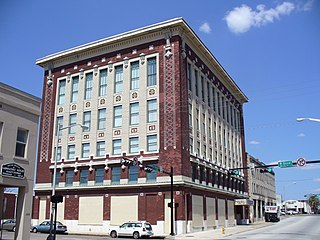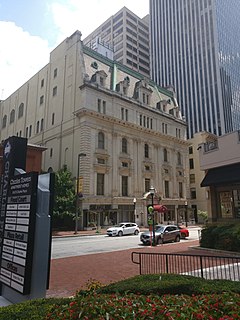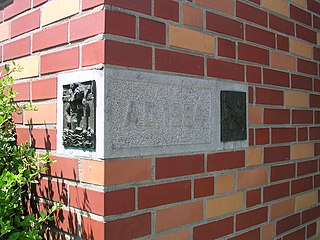
The George Washington Masonic National Memorial is a Masonic building and memorial located in Alexandria, Virginia, outside Washington, D.C. It is dedicated to the memory of George Washington, the first President of the United States and a Mason. The tower is fashioned after the ancient Lighthouse of Alexandria in Egypt. The 333-foot (101 m) tall memorial sits atop Shooter's Hill at 101 Callahan Drive. Construction began in 1922, the building was dedicated in 1932, and the interior finally completed in 1970. In July 2015, it was designated a National Historic Landmark for its architecture, and as one of the largest-scale private memorials to honor Washington.

The Most Worshipful Grand Lodge of Ancient Free and Accepted Masons of the Commonwealth of Massachusetts, commonly referred to as the Grand Lodge of Massachusetts and abbreviated GLMA, is the main governing body of Freemasonry within Massachusetts, and maintains Lodges in other jurisdictions overseas, namely Panama, Chile, the People's Republic of China, and Guantanamo Bay Naval Base, Cuba.

The Grand Lodge of Texas, Ancient Free and Accepted Masons is the largest of several governing bodies of Freemasonry in the State of Texas, being solely of the Ancients' tradition and descending from the Ancient Grand Lodge of England, founded in 1751. It was founded as "The Grand Lodge of the Republic of Texas, A.F. & A.M." on 16 April 1838. The Grand Lodge of Texas is one of the largest in the world, reporting 81,340 members in 2013. The current Grand Lodge of Texas facilities were made possible by the fundraising efforts of Waco Masonic Lodge No. 92. To learn about the building itself and how it got there, click here.

The Masonic Temple is a historic Masonic temple in Jacksonville, Florida. It is located at 410 Broad Street. Constructed by the Grand Lodge between 1901 and 1912, it was added to the U.S. National Register of Historic Places on September 22, 1980.

The Masonic Temple No. 25, the meeting location of Hillsborough Lodge No. 25, Free and Accepted Masons, is an historic Masonic building located at 508 East Kennedy Boulevard in Tampa, Florida, United States. Erected in 1927, the Lodge building was designed by Brother Leo Elliott whose design for it was inspired by three medieval Italian cathedrals.
In Craft Freemasonry, sometimes known as Blue Lodge Freemasonry, every Masonic Lodge elects or appoints Masonic Lodge Officers to execute the necessary functions of the lodge's life and work. The precise list of such offices may vary between the jurisdictions of different Grand Lodges, although certain factors are common to all, and others are usual in most.

The Grand is a Masonic temple located in Baltimore, Maryland. Constructed in 1866 by the Freemasons as the Grand Lodge of Maryland Masonic Temple, the building was the headquarters for the Maryland Freemasons for over 130 years. Edmund G. Lind was commissioned to design a new Masonic Temple. The French and Italian Renaissance-inspired property is a 7-story, 90,000 square foot building in downtown Baltimore. Among its ten main meeting rooms are Edinburgh Hall, modeled after the Tudor-style Rosslyn Chapel in Scotland, and another which resembles an Egyptian temple. The building features ornate plaster moldings, a marble staircase, stained glass windows and Rococo chandeliers.

The Montreal Masonic Memorial Temple is a historic masonic temple in Montreal, Quebec, Canada, on the corner of Sherbrooke Street and St. Marc Street, in the Golden Square Mile district. Dedicated and officially opened June February 12, 1930, it was designated a National Historic Site of Canada in 2001, as an example of one of Canada’s most elegant buildings in the Beaux-Arts style.

Hilo Masonic Lodge Hall, also known as the Bishop Trust Building, is a historic structure in Hilo, Hawaii. Constructed between 1908 and 1910, it was designed to house commercial space on the ground floor and a meeting hall for a local Masonic lodge on the second floor. The Masons stayed until around 1985.

The Masonic Temple is a historic Masonic building in Philadelphia. Located at 1 North Broad Street, directly across from Philadelphia City Hall, it serves as the headquarters of the Grand Lodge of Pennsylvania, Free and Accepted Masons. The Temple features the Masonic Library and Museum of Pennsylvania, and receives thousands of visitors every year to view the ornate structure, which includes seven lodge rooms, where today a number of Philadelphia lodges and the Grand Lodge conduct their meetings.

The Masonic Temple and Lodge are two adjacent Masonic buildings in downtown Alameda, California. The older Masonic Temple at 1329–31 Park St was built from 1890 to 1891. The building was designed in the Victorian Eclectic style and features brick pier which extend above the roof line, a tower on the south side of the roof, and an arched stone entrance with carved doors.

The Masonic Temple of Citrus Lodge No. 118, F. and A.M. refers to a historic 3-story building designed by prominent Florida architect Wilbur B. Talley and built in 1910 at the corner of West Main Street and South Pine Avenue in Inverness, Citrus County, Florida. It is also known as Inverness Masonic Temple. As was common with American Masonic buildings of the time, the first floor was used for retail stores, while the second floor was used for professional offices and the third floor was used for the lodge hall and other Masonic uses. Over the years, the second floor also housed the city hall and a movie theater. After repairing the fire damage from a lightning strike in 1963, Citrus Lodge decided to build a new building at 301 Hendrix Avenue and vacated the premises in 1965. The building was then sold to a series of private owners. In 1990 the Board of County Commissioners rented the third floor for a few years. Recent uses include the building management office on the ground floor, bookkeepers, attorneys, insurance agents, therapists, tutor services and an AA Intergroup office on the other floors.

The Masonic Temple in Kirksville, Missouri serves as the home for Kirksville Masonic lodge No. 105. The structure was listed on the National Register of Historic Places on January 7, 2010.

M. Leo Elliott was an architect known for his work in Tampa, Temple Terrace and Sarasota, Florida. His designs include the public buildings and first eight houses in the City of Temple Terrace, Florida (1921), Ybor City's Centro Asturiano de Tampa, Old Tampa City Hall, Osprey School, two buildings that were part of Florida College and the original Temple Terrace Estates, Masonic Temple No. 25 (1928), the 1920 addition to Sarasota High School and Historic Spanish Point. Several of the properties are listed on the National Register of Historic Places.

The Auburn Masonic Temple is located at 10 Auburn Way South in Auburn, Washington. The building was listed on the National Register of Historic Places in 2015 and is significant for various reasons. The building is "an unusually sophisticated, urban version of fraternal architecture for a town of less than 3,500. It remains today the only fraternal hall in the city still in its original use."

The Island Grove Masonic Lodge No. 125 is a historic building in Alachua County. It was added to the National Register of Historic Places on December 7, 2010. It is located at 20114 Southeast 219 Avenue.

The Asheville Masonic Temple is a Masonic Temple located in Asheville, North Carolina. Designed by British American architect and Freemason Richard Sharp Smith, the building was opened in April 1915. It is listed in the United States National Register of Historic Places as a contributing building in the Downtown Asheville Historic District.

The United States Capitol cornerstone laying was the ceremonial placement of the cornerstone of the United States Capitol on September 18, 1793. The cornerstone was laid by president of the United States George Washington, assisted by the Grand Master of Maryland Joseph Clark, in a Masonic ritual.




























